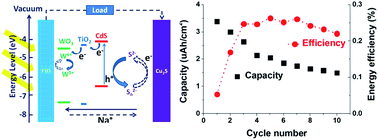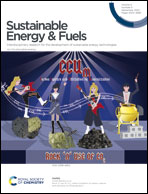A sustainable light-chargeable two-electrode energy storage system based on aqueous sodium-ion photo-intercalation†
Abstract
Direct photo-to-chemical energy conversion realized through photocatalysis could provide the ultimate solution to the intermittency problem of solar energy. Among different designs of photocatalytic solar energy storage systems, the two-electrode system offers the simplest configuration for enabling highly integrated solar energy conversion and storage in one electrode and on-demand electrocatalytic discharge in the other. In this study, a novel type of visible light chargeable two-electrode Na-ion energy storage system has been developed, to the best of our knowledge, for the first time. It consists of a WO3–(TiO2)–CdS photo absorbing, energy storing bi-functional electrode, a Pt foil counter electrode, and a sacrificial hole scavenging electrolyte. This device delivered a discharge capacity of 12.3 μA h cm−2 (or 18.1 mA h g−1) after 10 min light charging without exhibiting signs of photo/chemical corrosion on the chalcogenide sensitizer. Further by controlling the working voltage window, structure distortion due to overcharging was avoided, thereby leading to an improvement of cyclability (discharge capacity retention after 5 working cycles) from 36% to 64%, and this was eventually elevated to ∼90% upon optimizing the discharging rate. A stable overall solar-to-electrical energy efficiency of ∼0.3% has been achieved for the system. Moreover, a modified photo-rechargeable two-electrode system was developed by replacing the sacrificial hole scavenger and Pt with polysulfide aqueous electrolyte and Cu2S electrocatalytic electrode, respectively. In this way the issue of non-regenerable hole scavenger consumption and instability of Pt in sulfide electrolyte was resolved, establishing a new design, highly promising towards the development of an all-sustainable photo-rechargeable system.



 Please wait while we load your content...
Please wait while we load your content...